RESOURCE
Youth Thrive Blueprint
Tools and Resources for Putting Youth Thrive into Practice

RESOURCE
Tools and Resources for Putting Youth Thrive into Practice
Users are encouraged to reflect on where they are in implementing Youth Thrive (e.g., just getting started or having completed the Youth Thrive training(s)) and also to consider:
For additional support and technical assistance with implementing Youth Thrive, please contact the Youth Thrive team at YouthThrive@CSSP.org.
Practice refers to all of the ways youth-serving professionals interact with young people. The Blueprint is focused on strengthening and shifting practice so that young people are at the forefront when making decisions and leading change. Examples of practice include:
However, practice alone cannot improve outcomes and support young people in reaching their full potential. Systems and all that they encompass—the people, policies, procedures, funding streams, and decision-making structures—need to pivot and lead the charge in valuing young people, their voice, choice, and power. Systems need to combat and address the systemic racism and biases that lead to inequitable access to resources and poor outcomes for young people, especially for Black, Indigenous, Latinx/e, and LGBTQ+ young people.
Young people are thriving when:
Families, communities, organizations, systems and society have central roles in helping young people thrive. They:
When asked at the 2019 Youth Thrive Convening, “What does thriving mean to you?,” young people shared:
“I know I will be okay no matter what happens.”
”Having hope for the future.”
”Being loved well and loving others well.”
“Thriving is when I elevate my potential/strength!”
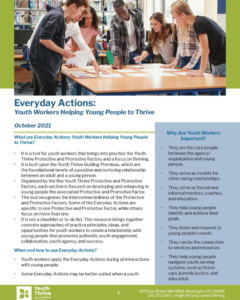 What are Everyday Actions: Youth Workers* Helping Young People
What are Everyday Actions: Youth Workers* Helping Young People* Throughout the Blueprint, we refer to the “worker.” By “worker,” we generally mean any staff member who directly works with young people and their families. This may include caseworkers, teachers, recreation workers, counselors, advocates, etc.
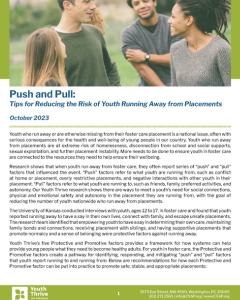 This brief provides recommendations for how each Protective and Promotive factor can be put into practice to promote safe, stable, and appropriate placements for youth in foster care.
This brief provides recommendations for how each Protective and Promotive factor can be put into practice to promote safe, stable, and appropriate placements for youth in foster care.
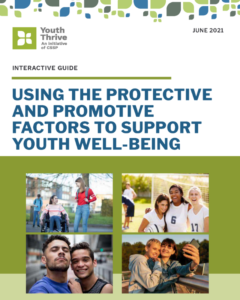 This interactive guide is designed to provide those working with young people—as well as youth themselves and their parents—with questions that stimulate and enrich conversations about the presence of the Youth Thrive Protective and Promotive Factors in a young person’s life, each of which help to reduce risk, increase the likelihood of positive outcomes, and support healthy development and well-being.
This interactive guide is designed to provide those working with young people—as well as youth themselves and their parents—with questions that stimulate and enrich conversations about the presence of the Youth Thrive Protective and Promotive Factors in a young person’s life, each of which help to reduce risk, increase the likelihood of positive outcomes, and support healthy development and well-being.
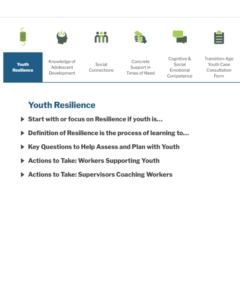 The Youth Thrive Coaching Tool is designed to give supervisors key questions, guidance, and ideas about how to help workers* assess and support Protective and Promotive Factors with youth.
The Youth Thrive Coaching Tool is designed to give supervisors key questions, guidance, and ideas about how to help workers* assess and support Protective and Promotive Factors with youth.
* Throughout the Blueprint, we refer to the “worker.” By “worker,” we generally mean any staff member who directly works with young people and their families. This may include caseworkers, teachers, recreation workers, counselors, advocates, etc.
The Youth Thrive Survey™ is a valid and reliable youth self-report instrument that measures the presence, strength, and growth of the Youth Thrive Protective and Promotive Factors as proxy indicators of well-being.
 This resource explores how teaming meetings build and strengthen young people’s Protective and Promotive Factors (PPFs) and includes considerations for how to elevate young people’s voice and engagement in teaming meetings.
This resource explores how teaming meetings build and strengthen young people’s Protective and Promotive Factors (PPFs) and includes considerations for how to elevate young people’s voice and engagement in teaming meetings.
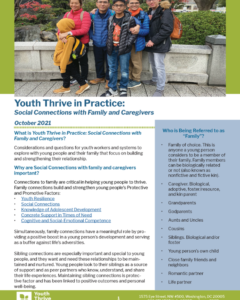
This brief provides considerations and questions for youth workers* and systems to explore with young people and their family that focus on building and strengthening their relationship.
* Throughout the Blueprint, we refer to the “worker.” By “worker,” we generally mean any staff member who directly works with young people and their families. This may include caseworkers, teachers, recreation workers, counselors, advocates, etc.
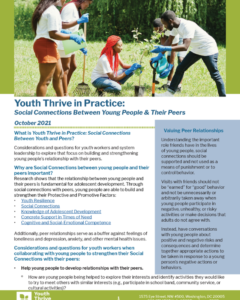 This brief provides considerations and questions for youth workers* and system leadership to explore that focus on building and strengthening young people’s relationship with their peers.
This brief provides considerations and questions for youth workers* and system leadership to explore that focus on building and strengthening young people’s relationship with their peers.
* Throughout the Blueprint, we refer to the “worker.” By “worker,” we generally mean any staff member who directly works with young people and their families. This may include caseworkers, teachers, recreation workers, counselors, advocates, etc.
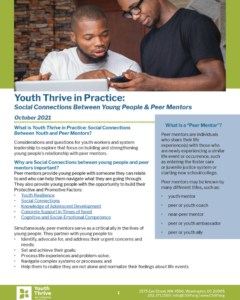 This brief provides considerations and questions for youth workers* and system leadership to explore that focus on building and strengthening young people’s relationship with peer mentors.
This brief provides considerations and questions for youth workers* and system leadership to explore that focus on building and strengthening young people’s relationship with peer mentors.
* Throughout the Blueprint, we refer to the “worker.” By “worker,” we generally mean any staff member who directly works with young people and their families. This may include caseworkers, teachers, recreation workers, counselors, advocates, etc.
These resources bring together Youth Thrive with existing programs and approaches and highlight opportunities to help young people.
A graphic that is a visual companion to the Youth Thrive Matrix.
While all of the leaves are important, it is not expected that an agency/organization can address all of them at once. Instead, one should identify specific opportunities based on fit with your organization’s priorities, plans, resources (human and financial), and momentum for change.
Practice can always be improved and is never static. The purpose of the Vine and Matrix is to help improve agency’s/ organization’s youth-centered practices by moving along a continuum of leaves—from good to exemplary practice:
Each new leaf adds on from the prior description—progressing from good to strong to exemplary practice.
Questions, considerations, and action items for an agency/organization to explore to determine if their practices promote and advance thriving.
Anyone who wants to explore the many areas that impact practice and to identify opportunities to help young people thrive. Individual workers* can use the Matrix to improve their own practice. Organizational transformation must come from an agency’s buy-in and leadership’s commitment to change.
* Throughout the Blueprint, we refer to the “worker.” By “worker,” we generally mean any staff member who directly works with young people and their families. This may include caseworkers, teachers, recreation workers, counselors, advocates, etc.
Guide to Using the Youth Thrive Vine & Matrix
If you are new to Youth Thrive, below are resources and information to learn more. Systems and organizations interested in implementing Youth Thrive may refer to Building the Youth Thrive Framework in Jurisdictions and the Creating a Thriving Culture section of the Blueprint.
Youth Thrive is:
| |
Youth Resilience |
| Cognitive and Social-Emotional Competence |
Youth Thrive advances practices and approaches that create opportunities for positive experiences, learning, supportive and transformative relationships, and healing.
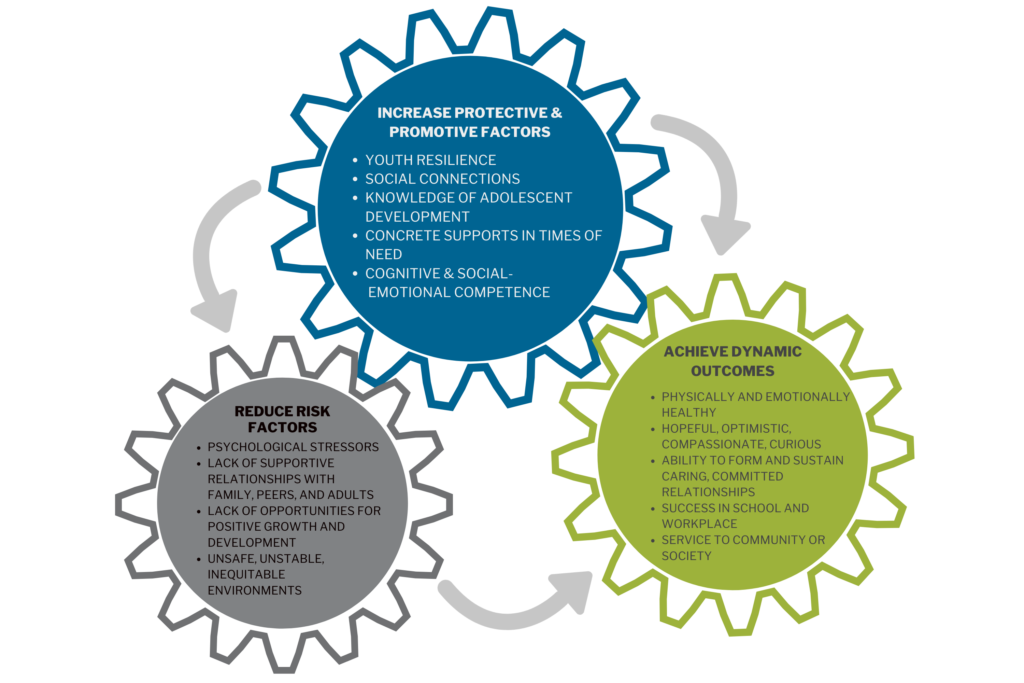
Click to enlarge the Youth Thrive Theory of Change
The Youth Thrive Framework Theory of Change provides a clear and compelling way to think about what youth need in order to thrive by showcasing the five protective and promotive factors that mitigate risks and promote well-being so that all young people achieve dynamic outcomes.
The Youth Thrive Premises are the foundation for this critical work with youth and help staff understand and address the personal and systemic barriers youth face today.
The Youth Thrive Trainings focus on strengthening the capacity of systems to support young people. This includes training various staff members who have direct contact with young people—youth workers,* supervisors, probation, school resource and police officers, service providers—about the protective and promotive factors young people need to thrive and how to apply this new knowledge to their interactions with young people.
For more information about the Youth Thrive Training menu, visit the Youth Thrive Training webpage. To learn more about the Youth Thrive curricula or to schedule a training, email YouthThrive@CSSP.org.
* Throughout the Blueprint, we refer to the “worker.” By “worker,” we generally mean any staff member who directly works with young people and their families. This may include caseworkers, teachers, recreation workers, counselors, advocates, etc.
The Youth Thrive Survey™ is a valid and reliable youth self-report instrument that measures the presence, strength, and growth of the Youth Thrive Protective and Promotive Factors as proxy indicators of well-being.
The Youth Thrive Survey is free and provides an array of data reports that can be used to inform policy and practice decisions and measure positive indicators of well-being for youth and young adults.
The Youth Thrive Survey is available in both English and Spanish. To set up a new account, follow the instructions in the Youth Thrive Survey User Manual. Additional information about the survey is available via the Youth Thrive Survey webpage, the Youth Thrive Survey one-pager, tip sheet for youth-serving professionals, and Using Data from the Youth Thrive Survey to Improve Practice.
If you have any questions about the Youth Thrive Survey, or need support, please complete this questionnaire to request assistance.
Below are links to a variety of external resources that encourage and reinforce practices to help young people thrive.
James Bell Associates—Measuring Child Welfare Outcomes: A Compendium of Standardized Instruments. Tables 7 to 9 include lists of various instruments that assess strengths, resilience, and protective factors; self-esteem/self-identity; and service needs (starting on page 21).